
Yeovil Junction is the busier,but less central,of two railway stations serving the town of Yeovil in Somerset,England;the other is Yeovil Pen Mill. The station is sited 2 miles (3.2 km) outside the town,in the village of Stoford;although Yeovil is in Somerset,the station was in Dorset until 1991. It is located 122 miles 48 chains (197.3 km) down the line from London Waterloo.

The West of England line is a British railway line from Basingstoke,Hampshire,to Exeter St Davids in Devon,England. Passenger services run between London Waterloo station and Exeter;the line intersects with the Wessex Main Line at Salisbury. Despite its historic title,it is not today's principal route from London to the West of England:Exeter and everywhere further west are reached more quickly from London Paddington via the Reading–Taunton line.

Exeter St Davids railway station is the principal and largest railway station in Exeter,also the second-busiest station in Devon.

Gillingham railway station serves the town of Gillingham,Dorset,England. It is on the West of England Main Line,105 miles 23 chains (169.4 km) down the line from London Waterloo. Today it is managed by South Western Railway. The main offices,designed by Sir William Tite,stand on the north side of the line.
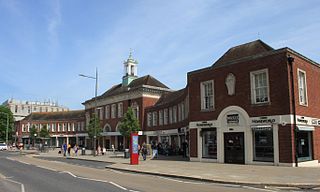
Exeter Central railway station is the most central of the stations in the city of Exeter,Devon,United Kingdom. It is 171 miles 30 chains (275.8 km) down the line from London Waterloo. The station is smaller than Exeter St Davids on the west side of the city. Great Western Railway manages the station and operates most services,with South Western Railway providing the rest. With 2.783 million entries and exits from 2023-2024,it has overtaken Exeter St Davids as the busiest station in Devon.
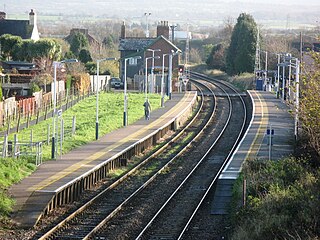
Pinhoe railway station is a railway station located on the eastern edge of the city of Exeter in Devon,England,that serves the village of Pinhoe. It was opened by the London and South Western Railway (LSWR) in 1871,but is now operated by South Western Railway,which provides services on the West of England Main Line. It is 168 miles 44 chains (271.3 km) down the line from London Waterloo.

Whimple railway station serves the village of Whimple in east Devon,England. It is operated by South Western Railway which provides services on the West of England Main Line. It is 163 miles 2 chains (262.4 km) down the line from London Waterloo.

Feniton railway station serves the village of Feniton in Devon,England. It was opened by the London and South Western Railway (LSWR) in 1860 but is now operated by South Western Railway which provides services on the West of England Main Line. It is 159 miles 24 chains (256.4 km) down the line from London Waterloo.

Honiton railway station serves the town of Honiton in east Devon,England. It is operated by South Western Railway and is 154 miles 60 chains (249.0 km) down the line from London Waterloo,on the West of England Line.

Axminster railway station serves the town of Axminster in Devon,England. It is operated by South Western Railway and is situated on the West of England Main Line. It is 144 miles 41 chains (232.6 km) down the line from London Waterloo.

Crewkerne railway station is located in Misterton in Somerset,England,and serves the area around the town of Crewkerne. It is 131 miles 33 chains (211.5 km) from London Waterloo on the West of England Main Line to Exeter. The main building is listed Grade II and is surrounded by several other old railway buildings.
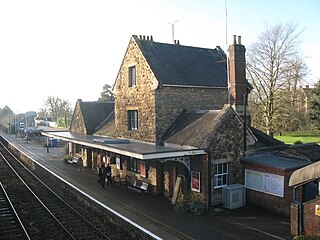
Sherborne railway station serves the town of Sherborne in Dorset,England. It is situated on the West of England Main Line,118 miles 4 chains (190.0 km) down the line from London Waterloo and is currently operated by South Western Railway.

Templecombe railway station serves the village of Templecombe in Somerset,England. It is situated on the West of England Main Line,112 miles 2 chains (180.3 km) down the line from London Waterloo. The main station opened in 1860 but a smaller station on the lower line opened in 1862. It was closed in 1966 but was reopened in 1983 following local community pressure. It is currently operated by South Western Railway.

Salisbury railway station serves the cathedral city of Salisbury in Wiltshire,England. It is 83 miles 43 chains (134.4 km) from London Waterloo on the West of England line to Exeter St Davids. This is crossed by the Wessex Main Line from Bristol Temple Meads to Southampton Central. The station is operated and served by South Western Railway (SWR),and is also served by Great Western Railway (GWR).
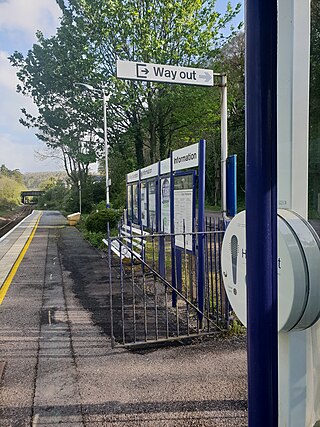
Kings Nympton railway station,also spelt King's Nympton,is a request stop on the Tarka Line in North Devon,serving the civil parishes of Chulmleigh,Burrington and King's Nympton. The station is located at Fortescue Cross,a road junction on the A377,around 2+1⁄2 miles (4 km) from its namesake village. It is 26 miles 21 chains (42.3 km) from Exeter Central at milepost 197.75 from London Waterloo. The station and all trains are operated by Great Western Railway (GWR).
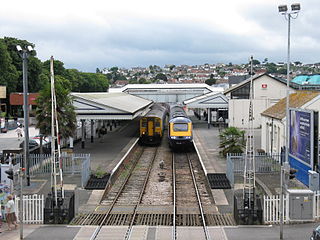
Paignton railway station serves the town and seaside resort of Paignton in Devon,England. It is 222 miles 12 chains (358 km) from London Paddington,via Box. It opened in 1859 and is now the terminus of Riviera Line services from Exeter and heritage services on the Dartmouth Steam Railway from Kingswear.
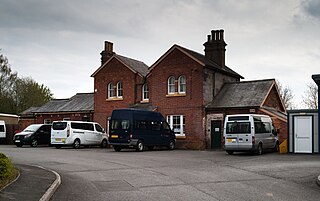
Wilton South railway station is a disused railway station which served Wilton in Wiltshire,England,on the West of England line from London Waterloo to Exeter.

Chard Junction railway station was situated on the London and South Western Railway’s West of England Main Line about 1 mile (1.6 km) southeast of the village of Tatworth in Somerset,England. It was the junction of a short branch line to Chard. It was opened in 1860 as Chard Road,and closed in 1966. An adjacent milk depot was served by its own sidings from 1937 to 1980. Chard Junction signal box remained open to control Station Road level crossing and a passing loop on the long section of single track railway between Yeovil Junction and Pinhoe until March 2021,when control was passed to Basingstoke.
The Salisbury and Yeovil Railway linked Salisbury (Wiltshire),Gillingham (Dorset) and Yeovil (Somerset) in England. Opened in stages in 1859 and 1860,it formed a bridge route between the main London and South Western Railway (LSWR) network and its lines in Devon and Cornwall. Its trains were operated by the LSWR and it was sold to that company in 1878. Apart from a short section in Yeovil it remains open and carries the London Waterloo to Exeter service of South Western Railway.

Dinton railway station is a disused railway station which formerly served Dinton in Wiltshire,England. It was situated on the West of England Main Line from London Waterloo station to Exeter. It was opened in 1859 and closed to passengers in 1966 and to general goods traffic in 1967. In the First World War,it was the junction for the Fovant Military Railway. The station was about ½mile from the centre of the village.





















